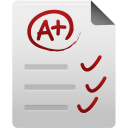Here are the Chapter 7 food for thought questions:
- What is a hypothesis? What is the distinction between a hypothesis and a prediction?
- What information does the researcher communicate in each of the sections of a research article?
- What are the two functions of a theory?
- Think of at least one “commonsense” saying about behavior (e.g., “Spare the rod, spoil the child”; “Like father, like son”‘; “Absence makes the heart grow fonder”). For each, develop a hypothesis that is suggested by the saying and a prediction that follows from the hypothesis. (Based on Gardner, 1988.)
- Identify the four steps in hypothesis testing.
- Define null hypothesis, alternative hypothesis, level of significance, test statistic, p value, and statistical significance.
- Define Type I error and Type II error, and identify the type of error that researchers control.
- What strategies can researchers use to control Type I and Type II error? Give specific examples.
- Explain the concept of significance and why it is important.
- What is a confidence interval?
- Distinguish between a one-tailed test and a two-tailed test, and explain why a Type III error is possible only with one-tailed tests.
- Define power and identify six factors that influence power.
- If the null hypothesis is rejected, did we reach significance? Explain.
- A researcher conducts a one-sample z test. The z statistic for the upper-tail critical test at a .05 level of significance is zobt = 1.84. What is the decision for this test?
- As effect size increases, what happens to the power?
- As effect size decreases, what happens to the power?
- When a population is associated with a small effect size, what can a researcher do to increase the power of the study?
Is this your assignment or some part of it?
We can do it for you! Click to Order!








